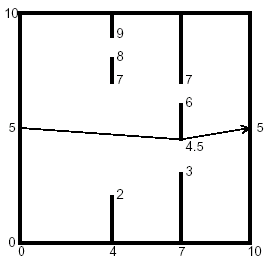【POJ】1556 The Doors(计算几何基础+spfa)
http://poj.org/problem?id=1556
首先路径的每条线段一定是端点之间的连线。证明?这是个坑...反正我是随便画了一下图然后就写了..
然后re是什么节奏?我记得我开够了啊...然后再开大点才a...好囧啊.
#include <cstdio>
#include <cstring>
#include <cmath>
#include <string>
#include <iostream>
#include <algorithm>
#include <queue>
#include <set>
#include <map>
using namespace std;
typedef long long ll;
#define rep(i, n) for(int i=0; i<(n); ++i)
#define for1(i,a,n) for(int i=(a);i<=(n);++i)
#define for2(i,a,n) for(int i=(a);i<(n);++i)
#define for3(i,a,n) for(int i=(a);i>=(n);--i)
#define for4(i,a,n) for(int i=(a);i>(n);--i)
#define CC(i,a) memset(i,a,sizeof(i))
#define read(a) a=getint()
#define print(a) printf("%d", a)
#define dbg(x) cout << (#x) << " = " << (x) << endl
#define error(x) (!(x)?puts("error"):0)
#define rdm(x, i) for(int i=ihead[x]; i; i=e[i].next)
inline const int getint() { int r=0, k=1; char c=getchar(); for(; c<'0'||c>'9'; c=getchar()) if(c=='-') k=-1; for(; c>='0'&&c<='9'; c=getchar()) r=r*10+c-'0'; return k*r; } const double eps=1e-6;
int dcmp(double x) { return abs(x)<eps?0:(x<0?-1:1); }
struct ipoint { double x, y; };
double icross(ipoint &a, ipoint &b, ipoint &c) {
static double x1, x2, y1, y2;
x1=a.x-c.x; y1=a.y-c.y;
x2=b.x-c.x; y2=b.y-c.y;
return x1*y2-x2*y1;
}
int ijiao(ipoint &p1, ipoint &p2, ipoint &q1, ipoint &q2) {
return (dcmp(icross(p1, q1, q2))^dcmp(icross(p2, q1, q2)))==-2 &&
(dcmp(icross(q1, p1, p2))^dcmp(icross(q2, p1, p2)))==-2;
} const int N=1000;
struct dat { int next, to; double w; }e[N<<2];
int ihead[N], cnt;
void add(int u, int v, double w) {
e[++cnt].next=ihead[u]; ihead[u]=cnt; e[cnt].to=v; e[cnt].w=w;
}
double spfa(int s, int t, int n) {
static double d[N];
static int q[N], front, tail, u, v;
static bool vis[N];
front=tail=0;
for1(i, 0, n) vis[i]=0, d[i]=1e99;
d[s]=0; q[tail++]=s; vis[s]=1;
while(front!=tail) {
u=q[front++]; if(front==N) front=0; vis[u]=0;
rdm(u, i) if(d[v=e[i].to]+eps>d[u]+e[i].w) {
d[v]=d[u]+e[i].w;
if(!vis[v]) {
vis[v]=1;
if(d[v]<d[q[front]]+eps) {
--front; if(front<0) front+=N;
q[front]=v;
}
else { q[tail++]=v; if(tail==N) tail=0; }
}
}
}
return d[t];
} ipoint p[N], line[N*3][2];
int n, pn, ln; bool check(ipoint &x, ipoint &y) {
for1(i, 1, ln) if(ijiao(x, y, line[i][0], line[i][1])) return false;
return true;
}
double sqr(double x) { return x*x; }
double dis(ipoint &x, ipoint &y) { return sqrt(sqr(x.x-y.x)+sqr(x.y-y.y)); } int main() {
while(read(n), n!=-1) {
ln=0; pn=0;
++pn; p[pn].x=0; p[pn].y=5;
++pn; p[pn].x=10; p[pn].y=5;
static double rx, ry[4];
while(n--) {
scanf("%lf", &rx);
rep(k, 4) scanf("%lf", &ry[k]);
++ln; line[ln][0]=(ipoint){rx, 0}; line[ln][1]=(ipoint){rx, ry[0]};
++ln; line[ln][0]=(ipoint){rx, ry[1]}; line[ln][1]=(ipoint){rx, ry[2]};
++ln; line[ln][0]=(ipoint){rx, ry[3]}; line[ln][1]=(ipoint){rx, 10};
rep(k, 4) ++pn, p[pn].x=rx, p[pn].y=ry[k];
}
for1(i, 1, pn) for1(j, 1, pn) if(i!=j && check(p[i], p[j])) add(i, j, dis(p[i], p[j]));
printf("%.2f\n", spfa(1, 2, pn)); memset(ihead, 0, sizeof(int)*(pn+1));
cnt=0;
}
return 0;
}
Description

Input
2
4 2 7 8 9
7 3 4.5 6 7
The first line contains the number of interior walls. Then there is a line for each such wall, containing five real numbers. The first number is the x coordinate of the wall (0 < x < 10), and the remaining four are the y coordinates of the ends of the doorways in that wall. The x coordinates of the walls are in increasing order, and within each line the y coordinates are in increasing order. The input file will contain at least one such set of data. The end of the data comes when the number of walls is -1.
Output
Sample Input
1
5 4 6 7 8
2
4 2 7 8 9
7 3 4.5 6 7
-1
Sample Output
10.00
10.06
Source
【POJ】1556 The Doors(计算几何基础+spfa)的更多相关文章
- POJ 1556 - The Doors 线段相交不含端点
POJ 1556 - The Doors题意: 在 10x10 的空间里有很多垂直的墙,不能穿墙,问你从(0,5) 到 (10,5)的最短距离是多少. 分析: 要么直达,要么 ...
- POJ 1556 The Doors 线段交 dijkstra
LINK 题意:在$10*10$的几何平面内,给出n条垂直x轴的线,且在线上开了两个口,起点为$(0, 5)$,终点为$(10, 5)$,问起点到终点不与其他线段相交的情况下的最小距离. 思路:将每个 ...
- POJ 1556 - The Doors - [平面几何+建图spfa最短路]
题目链接:http://poj.org/problem?id=1556 Time Limit: 1000MS Memory Limit: 10000K Description You are to f ...
- poj 1556 The Doors
The Doors Time Limit: 1000 MS Memory Limit: 10000 KB 64-bit integer IO format: %I64d , %I64u Java ...
- POJ 1556 The Doors【最短路+线段相交】
思路:暴力判断每个点连成的线段是否被墙挡住,构建图.求最短路. 思路很简单,但是实现比较复杂,模版一定要可靠. #include<stdio.h> #include<string.h ...
- POJ 1556 The Doors --几何,最短路
题意: 给一个正方形,从左边界的中点走到右边界的中点,中间有一些墙,问最短的距离是多少. 解法: 将起点,终点和所有墙的接触到空地的点存下来,然后两两之间如果没有线段(墙)阻隔,就建边,最后跑一个最短 ...
- POJ 1556 The Doors(线段交+最短路)
The Doors Time Limit: 1000MS Memory Limit: 10000K Total Submissions: 5210 Accepted: 2124 Descrip ...
- poj 1556 The Doors(线段相交,最短路)
The Doors Time Limit: 1000MS Memory Limit: 10000K Total Submissions: 7430 Accepted: 2915 Descr ...
- POJ 1556 The Doors 线段判交+Dijkstra
The Doors Time Limit: 1000MS Memory Limit: 10000K Total Submissions: 6734 Accepted: 2670 Descrip ...
随机推荐
- [ruby on rails] 跟我学之(4)路由映射
前面<[ruby on rails] 跟我学之Hello World>提到,路由对应的文件是 config/routes.rb 实际上我们只是添加了一句代码: resources :pos ...
- 分享一个强大的采集类,还可以模拟php多进程
做采集的时候,可以使用file_get_contents()去获取网页源代码,但是使用file_get_contents采集,速度慢,而且超时时间,不好控制.如果采集的页面不存在,需要等待的时间很长. ...
- Unique Paths | & ||
Unique Paths I A robot is located at the top-left corner of a m x n grid (marked 'Start' in the diag ...
- iOS 图片拉伸的解释
以前对于ios的图片拉伸参数一直不太理解,终于看到一篇好文章,转载一下,原文地址:http://blog.csdn.net/q199109106q/article/details/8615661 主要 ...
- iOS 中constraint 不等于约束和低优先级约束使用的简单体会
看了些文章发现,在使用constraint时,不等于约束往往是和低优先级约束成对使用的,这样才能实现他们的效果. 看看例子 下面是在3.5存屏幕下的效果 图1,竖屏,在满足>=50的前提下,可以 ...
- sqlite 使用记录
2014年8月13日 18:20:52 SQLite中创建自增字段: 简单的回答:一个声明为 INTEGER PRIMARY KEY 的字段将自动增加. 从 SQLite 的 2.3.4 版本开始,如 ...
- 基因变异(codevs 3194)
题目描述 Description 小毛终于来到了冥王星,这是一颗已经不属于行星的矮行星,它的表面温度低于-220度.在这里,小毛惊奇的发现,他带来的厌氧菌开始了基因变异,裂变的速度与光照时间(秒)成乘 ...
- 一箭双雕打开Genesis
打开记事本,将如下内容填入,保存时将后缀名改为bat @ ECHO 正在清理垃圾文件...del C:\tmp\*.* /f /q@ ECHO 清理完毕@ ECHO OFF@ ECHO.@ ECHO. ...
- sina发现并不会去导入qq使用的
看问题需要多角度,为之不能实现也是有可能没有完善的.确实是由于短时间发布过多,还是bky好点好像有30S
- 多个div 一行显示的处理方式
1.方式一: 通过div的float属性,定义宽度,然后定义float属性和width的属性,实现多个div在一行显示: 2.方式二: 通过div的display的属性,至少进行2成div的displ ...
